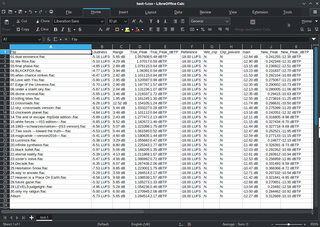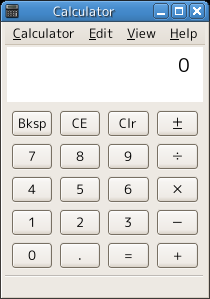In chemistry, a chemical formula is a way of presenting information about the chemical proportions of atoms that constitute a particular chemical compound or molecule, using chemical element symbols, numbers, and sometimes also other symbols, such as parentheses, dashes, brackets, commas and plus (+) and minus (−) signs. These are limited to a single typographic line of symbols, which may include subscripts and superscripts. A chemical formula is not a chemical name since it does not contain any words. Although a chemical formula may imply certain simple chemical structures, it is not the same as a full chemical structural formula. Chemical formulae can fully specify the structure of only the simplest of molecules and chemical substances, and are generally more limited in power than chemical names and structural formulae.

Microsoft Excel is a spreadsheet editor developed by Microsoft for Windows, macOS, Android, iOS and iPadOS. It features calculation or computation capabilities, graphing tools, pivot tables, and a macro programming language called Visual Basic for Applications (VBA). Excel forms part of the Microsoft 365 suite of software.

A spreadsheet is a computer application for computation, organization, analysis and storage of data in tabular form. Spreadsheets were developed as computerized analogs of paper accounting worksheets. The program operates on data entered in cells of a table. Each cell may contain either numeric or text data, or the results of formulas that automatically calculate and display a value based on the contents of other cells. The term spreadsheet may also refer to one such electronic document.

Lotus Improv is a discontinued spreadsheet program from Lotus Development released in 1991 for the NeXTSTEP platform and then for Windows 3.1 in 1993. Development was put on hiatus in 1994 after slow sales on the Windows platform, and officially ended in April 1996 after Lotus was purchased by IBM.

In science, a formula is a concise way of expressing information symbolically, as in a mathematical formula or a chemical formula. The informal use of the term formula in science refers to the general construct of a relationship between given quantities.
In computer science, a lookup table (LUT) is an array that replaces runtime computation with a simpler array indexing operation, in a process termed as direct addressing. The savings in processing time can be significant, because retrieving a value from memory is often faster than carrying out an "expensive" computation or input/output operation. The tables may be precalculated and stored in static program storage, calculated as part of a program's initialization phase (memoization), or even stored in hardware in application-specific platforms. Lookup tables are also used extensively to validate input values by matching against a list of valid items in an array and, in some programming languages, may include pointer functions to process the matching input. FPGAs also make extensive use of reconfigurable, hardware-implemented, lookup tables to provide programmable hardware functionality. LUTs differ from hash tables in a way that, to retrieve a value with key , a hash table would store the value in the slot where is a hash function i.e. is used to compute the slot, while in the case of LUT, the value is stored in slot , thus directly addressable.
Essbase is a multidimensional database management system (MDBMS) that provides a platform upon which to build analytic applications. Essbase began as a product from Arbor Software, which merged with Hyperion Software in 1998. Oracle Corporation acquired Hyperion Solutions Corporation in 2007. Until late 2005 IBM also marketed an OEM version of Essbase as DB2 OLAP Server.
A pivot table is a table of values which are aggregations of groups of individual values of a more extensive table within one or more discrete categories. The aggregations or summaries on the groups of the individual terms might include sums, averages, counts, or other statistics. A pivot table is an outcome of statistically processing on a tabularized raw data and can be used for decision making.
A worksheet, in the word's original meaning, is a sheet of paper on which one performs work. They come in many forms, most commonly associated with children's school work assignments, tax forms, and accounting or other business environments. Software is increasingly taking over the paper-based worksheet.
ExtenXLS is a Java Excel Reporting Toolkit developed by Extentech. It is a Reporting API that allows for the reading in, modifying and creation of spreadsheet-based reports from Java applications.

Origin is a proprietary computer program for interactive scientific graphing and data analysis. It is produced by OriginLab Corporation, and runs on Microsoft Windows. It has inspired several platform-independent open-source clones and alternatives like LabPlot and SciDAVis.

Numbers is a spreadsheet application developed by Apple Inc. as part of the iWork productivity suite alongside Keynote and Pages. Numbers is available for iOS and macOS High Sierra or newer. Numbers 1.0 on OS X was announced on August 7, 2007, making it the newest application in the iWork suite. The iPad version was released on January 27, 2010. The app was later updated to support iPhone and iPod Touch.
In computing science and informatics, nesting is where information is organized in layers, or where objects contain other similar objects. It almost always refers to self-similar or recursive structures in some sense.

A software calculator is a calculator that has been implemented as a computer program, rather than as a physical hardware device.

A formula calculator is a software calculator that can perform a calculation in two steps:
- Enter the calculation by typing it in from the keyboard.
- Press a single button or key to see the final result.

XLeratorDB is a suite of database function libraries that enable Microsoft SQL Server to perform a wide range of additional (non-native) business intelligence and ad hoc analytics. The libraries, which are embedded and run centrally on the database, include more than 450 individual functions similar to those found in Microsoft Excel spreadsheets. The individual functions are grouped and sold as six separate libraries based on usage: finance, statistics, math, engineering, unit conversions and strings. WestClinTech, the company that developed XLeratorDB, claims it is "the first commercial function package add-in for Microsoft SQL Server."
As with other spreadsheets, Microsoft Excel works only to limited accuracy because it retains only a certain number of figures to describe numbers. With some exceptions regarding erroneous values, infinities, and denormalized numbers, Excel calculates in double-precision floating-point format from the IEEE 754 specification. Although Excel allows display of up to 30 decimal places, its precision for any specific number is no more than 15 significant figures, and calculations may have an accuracy that is even less due to five issues: round off, truncation, and binary storage, accumulation of the deviations of the operands in calculations, and worst: cancellation at subtractions resp. 'Catastrophic cancellation' at subtraction of values with similar magnitude.
PROSE was the mathematical 4GL virtual machine that established the holistic modeling paradigm known as Synthetic Calculus. A successor to the SLANG/CUE simulation and optimization language developed at TRW Systems, it was introduced in 1974 on Control Data supercomputers. It was the first commercial language to employ automatic differentiation (AD), which was optimized to loop in the instruction-stack of the CDC 6600 CPU.
The functional database model is used to support analytics applications such as financial planning and performance management. The functional database model, or the functional model for short, is different from but complementary to the relational model. The functional model is also distinct from other similarly named concepts, including the DAPLEX functional database model and functional language databases.
Trapeze is a discontinued spreadsheet program for Macintosh systems running classic Mac OS. It introduced the concept of using named ranges for most operations instead of cell addresses, allowing formulas to be freed of the location of the data on the page. This, in turn, made updating the sheets by moving data around a safe operation, whereas in contemporary programs like Microsoft Excel and Lotus 1-2-3 this often led to broken formulas. The system did not rely on the sheet as the basis for storage, and allowed multiple tables, charts, graphics and text, which they referred to as "blocks", to be positioned freely.








